If are you planning a stargazing trip, then Joshua Tree National Park is the perfect place. It’s one of the best locations to stargaze in the US. You’ll want to choose the right time of year to visit. But when is the best time to go to Joshua Tree?
The best time to go to Joshua Tree for stargazing is during the ‘observing season’. This season lasts from the time when the clocks go back one hour in October (nights become 1-hour longer) to the time they go forward in March (nights become 1 hour shorter). If you’re planning a trip to Joshua Tree, then there are a few things to consider. In this article, I help you figure that out, and much more.
Stargazing provides you an opportunity to reconnect with nature and self. In the current era, stargazing may seem impossible as nobody has the time to go out for this amazing activity.

This article also covers other key attractions and activities, helping you to potentially combine several adventures in one trip. Most importantly though, you’ll get very useful information about the best time to go to Joshua Tree for stargazing.
In this article, you get
10 reasons to visit Joshua Tree
6 things to do in Joshua Tree
4 spots for stargazing
3 useful tips and more
Joshua Tree astrophotography
Best time to see Milky Way in Joshua Tree
My pick for the best place to stargaze in Joshua Tree
By the end of this article, you’ll know how and when is the best time to visit Joshua Tree for stargazing.
Let’s dive right in.
Recommended For You
WHERE IS JOSHUA TREE NATIONAL PARK?
Established on October 31, 1994, Joshua Tree National Park is situated in southern California, USA, less than a 3-hour drive from either San Diego or Los Angeles.
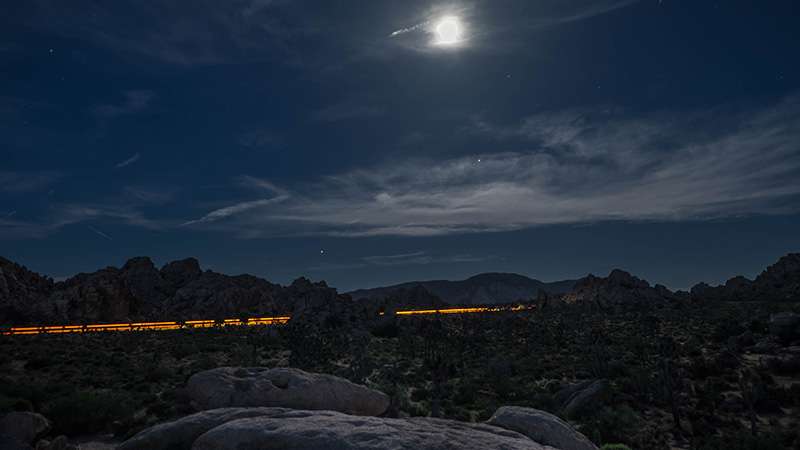
The park covers nearly 800,000 acres where the Mojave Desert meets the Colorado Desert. It tumbles down from the high elevations into the Coachload Valley, near Palm Springs.
The main Joshua Tree Visitor Center is located outside the park entrance, in the nearby town of Joshua Tree. There are only three ways you can enter the park; from Yucca Valley in the west, Cottonwood Spring in the south, and Twentynine Palms in the north.
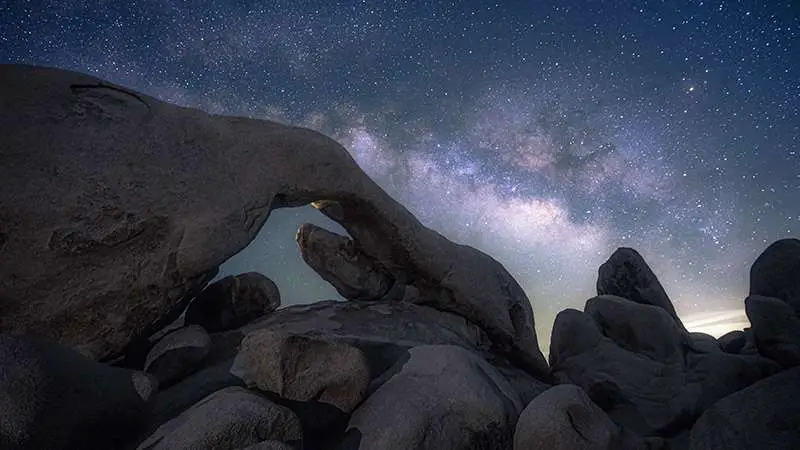
Twentynine Palms is known as the home of Joshua Tree National Park. The city is full of life, presenting a dynamic fusion of attractions for arts and culture lovers. If you love spending time outdoors, it’s a good idea to spend some time at Sky’s The Limit Observatory and Nature Center, located in Twentynine Palms.
WHY IS JOSHUA TREE FAMOUS FOR STARGAZING?
Joshua Tree National Park stargazing should be on your bucket list! Joshua Tree is one of the best places in the United States to view the Milky Way.
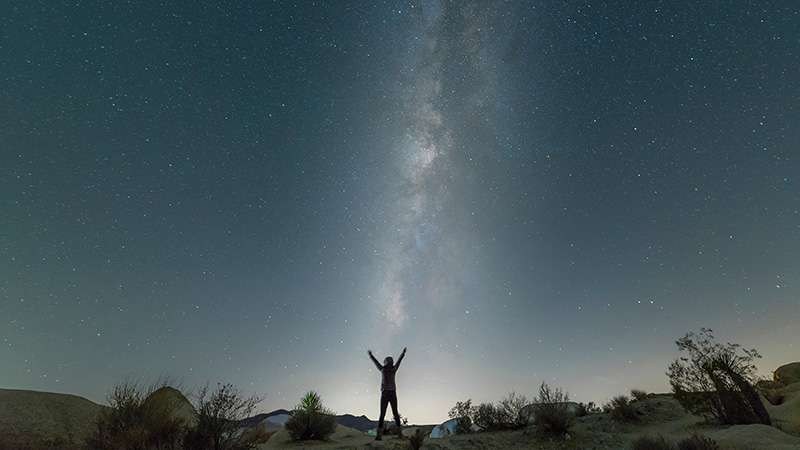
The park is designated as an International Dark Sky Park by the International Dark-Sky Association. This means you’ll be able to observe one of the darkest night skies you may have ever seen.
To learn more about what makes Joshua Tree such a great place for stargazing, read my article Dark Sky Map California.
If you’re new to stargazing, read my articles What Do You Need To Go Stargazing? and Is Stargazing Safe?
FREE STARGAZING CHECKLIST
My 5-page Stargazing Checklist will enhance your astronomical observations.
Follow this free checklist to navigate the night sky with confidence, clarity, and a sense of preparedness for a rewarding stargazing experience.

TOP 10 REASONS TO VISIT JOSHUA TREE
Star gazing Joshua Tree isn’t the only reason people come here.
In recent years, Joshua Tree National Park and adjacent communities have experienced an increase in the number of visitors. The spring and winter months are the busiest time periods at the park, but other seasons get a continuous flow of stargazers and ‘regular’ travelers too.
This is certainly due to the park’s amazing rock formations, huge variety of plants and animals, beautiful oases, and magical dark night skies.
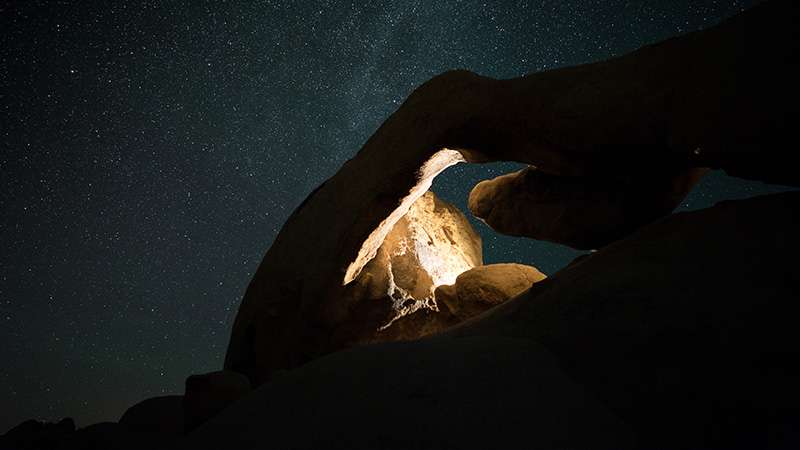
Another significant factor in the park’s popularity is its relative proximity to Los Angeles, permitting a traveler easy access to the park’s attractions. Whether you’re a true explorer or only a weekend visitor, here are the main reasons for you to visit Joshua Tree National Park.
Here are my top 10 reasons for you to visit Joshua Tree.
EASY ACCESSIBILITY FROM MAJOR CITIES
Unlike some other National Parks, which are located in remote locations, Joshua Tree is located near major cities in California state.
DIVERSE NATURAL LANDSCAPES
This natural park is home to diverse natural features, with higher elevations ranging from 900 feet to 5,000 feet above sea level. Here you’ll experience sightseeing of dunes, dry lakes, rugged mountains, and lush oases.
BEST PHOTO OPPORTUNITIES
This park is a great place for photographers. The boulders framed with Joshua trees under the blue sky create celestial scenery. The sunrise and sunset views in this national park are stunning. The amazing rock formations and the fantastic look of the Joshua trees against the clear skies make a scene that you’ll experience only here.
CAMPING FACILITIES
You’ll have to camp here if you’re considering spending the night in Joshua Tree National Park. Camping in this natural park offers a huge range of scenic locations. You’ll find nearly 500 campsites equipped with basic facilities.
Cottonwood Campground is considered to have the darkest skies. This campground is a great place for optimal stargazing. Many people consider Cottonwood to be the best Joshua Tree campground for stargazing.
AMAZING STARGAZING AT ITS BEST
In case you haven’t already guessed, or haven’t been paying attention, then I’ll just say it one more time here. Joshua Tree National Park is one of the best locations to stargaze in the US. The park is located in the high desert, far away from the major cities where light pollution is a major hindrance to stargaze clearly.
For more info, read my article Light Pollution Effects.
IT IS OPEN YEAR-ROUND
The weather is pleasant throughout the year. It gets hot during the summer months, but not as hot as in its nearby neighbor, Death Valley National Park.
IT OFFERS SOLITUDE
Despite its easy accessibility, you will find this park offers uninterrupted solitude. It’s a great spot to escape it all, including cell service.
AMAZING GRANITE BOULDERS
After Joshua trees, this national park is also famous for its fascinating huge boulder fields that serve as playgrounds for young and old. Because of these rocks, this park is a world-class rock-climbing destination.
EXCELLENT HIKING OPPORTUNITIES
Hiking in this park is fantastic, from short hikes to longer, challenging ones.
THE WILDLIFE
During your visit to Joshua Tree, you will come across 57 different species of mammals. This park possesses a variety of habitats; oases, dunes, valleys, rocks, and mountains. This diverse wildlife also includes 350 vertebrate species.
6 BEST THINGS TO DO IN JOSHUA TREE
Whether you’re a die-hard fan of nature, an outdoor enthusiast, or a traveler who’s never been to the desert, your trip to Joshua Tree is sure to be memorable. Here’s a short list of the main attractions in Joshua Tree.
Here’s my list of the 6 best things to do in Joshua Tree.
STARGAZING
Immerse yourself in a sky sprinkled with shining stars.
The night sky in Joshua Tree is perfect for mythical stargazing under dark skies. Far from the sometimes foggy Los Angeles, the desert offers a crystal clear night sky that makes it possible to spot all the constellations. Staying nearby offers you incredible nighttime views.
Stargazing in Joshua Tree gives you a chance to see the Milky Way – a once-in-a-lifetime experience for some. You may want to explore taking a Joshua Tree stargazing tour.
Pro Tip
Avoid visiting during the full moon, as the light can diminish your visibility of the stars. To learn more, read my article Can you still see stars with a full moon in Joshua Tree?
ROCK CLIMBING
You’ll find great opportunities for climbing, high lining, shouldering, and slacklining inside this national park.
Joshua Tree has over 8,000 climbing routes. Experienced rock climbers can enjoy adventurous climbing here, and amateurs can book one of many rock climbing classes.
Joshua Tree is a world-class climbing destination, so if you’re visiting the park and feeling adventurous, give it a try!
FORTY-NINE PALM OASIS
This oasis is surrounded by palm trees, thus it is named Forty-nine Palm Oasis. Discovering a lush oasis in the desert is a revitalizing experience; you shouldn’t miss this trail.
Since the trailhead for Forty-nine Palms Oasis Trail is located outside the park’s gates, this hike is free. The length of this trail is just over three miles but can be challenging in some parts.
On the trail, you’ll find scenic views of the valley and geometric rock formations. As you arrive in the oasis, you’ll see elevated, bushy palm trees that look a little out of place.
OTHER OUTDOOR ACTIVITIES
CAMPING
Joshua Tree National Park is one of the best places to camp in California.
Camping within or outside of Joshua Tree National Park in a tent or RV will give you easy access to the park and its trails. You can pitch a tent at Jumbo Rocks, or park your RV at Belle campground and enjoy the fantastic stargazing there.
Inside the park, you can pitch a tent at sites like Hidden Valley Campground and White Tank Campgrounds. These sites have old-styled restrooms, flush toilets, and fire grates, but no water, so pack plenty of water of your own.
Outside the park, you can easily book a private campground. The best weather for camping is early Spring and late Autumn. The intense heat during the hot summer months makes it not the perfect time for camping and stargazing.
CHOLLA CACTUS GARDEN
The Cholla Cactus Garden is home to fragrant creosote bushes and wildflowers that pepper the desert with color during spring.
The trail through is short, only 0.2 miles long, so it’s an easy feat for families with small children. This is also considered one of the best places for birding, hiking, and walking.
HORSEBACK RIDING
You can also explore Joshua Tree while horseback riding. Whether you intend to travel through Joshua Tree National Park on foot or horseback, the California Riding and Hiking Trail offers an exciting opportunity.
It’s a 38-mile-long trail that can take 4 days to complete. If you plan to take this hike, then be sure to bring plenty of food and water. The desert backcountry is quite dry and temperatures can climb rapidly.
HOW TO ARRIVE AT JOSHUA TREE
If you’re planning to visit Joshua Tree National Park, the nearest major airport is Los Angles International Airport. It’s a 2.5-hour drive from Los Angles to Joshua Tree.

If you don’t intend to drive, you could just as well hop on a flight to Palm Springs International Airport. Palm Springs is a short 45-minute drive to the south entrance.
HOW TO EXPERIENCE STARGAZING AT JOSHUA TREE
Inside the park, you’ll notice that the whole area is one gigantic stargazing spot.
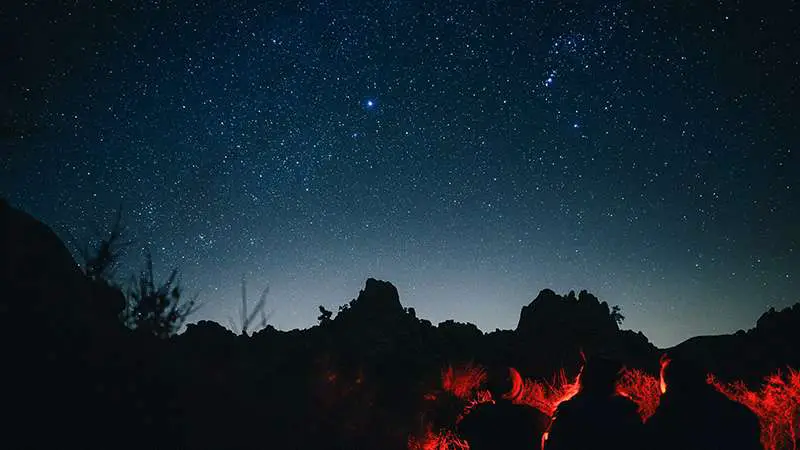
CAN YOU ENTER JOSHUA TREE AT NIGHT?
Yes, you can enter Joshua Tree at night. To learn more, read my article Is Joshua Tree free at night? If you’re not going to stay overnight in Joshua Tree, you can use any of the roadside pullouts to safely move your vehicle off the road and stargaze from these areas.
If you’re planning to camp in the park, most campgrounds offer the best areas for good stargazing.
BEST SPOTS FOR STARGAZING AT JOSHUA TREE
While you can view the night sky from everywhere in Joshua Tree National Park, some areas provide a little more interesting scene.
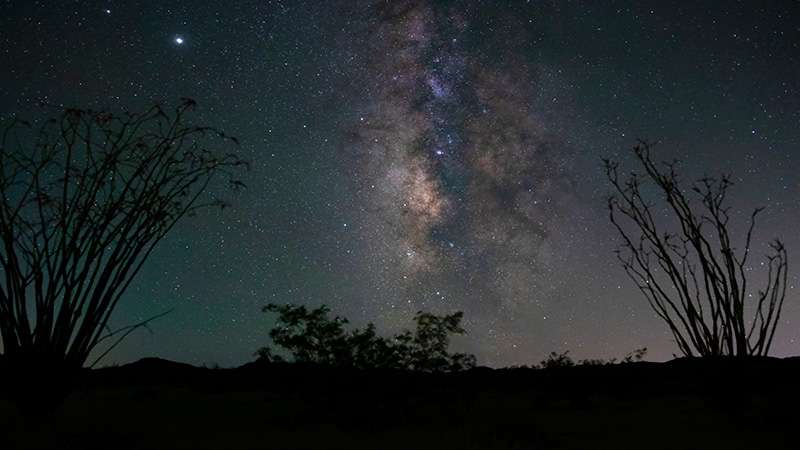
I’ve listed here the most famous Joshua Tree stargazing spots.
COTTONWOOD CAMPGROUND
Cottonwood Campground in Joshua Tree National Park is considered to have the darkest skies in the park. This campground is located near the Cottonwood Visitor Center in the southeast part of the park.
This campsite is equipped with the facilities of potable water and flush toilets. Campfires are permitted in designated fire rings or grills, which you will find in this campground.
The best overnight stargazing Joshua Tree offers is at Cottonwood Campground. It might be the best Joshua Tree stargazing location since you can sleep next to your equipment.
It certainly is the best campground in Joshua Tree for stargazing.
JUMBO ROCKS CAMPGROUND
Jumbo Rocks Campground is an 18-mile drive from the west entrance. This campsite is a good location within the park for access to trailheads. Jumbo Rock’s central location offers a great base camp to explore other areas of the park.
KEYS VIEW
This popular destination offers panoramic views of Coachella Valley. Keys View is considered the best spot to view the Salton Sea in one direction and Palm Springs in the other. This is one of the best stargazing spots in Joshua Tree.
ROADSIDE PULLOUTS
You can use any of the roadside pullouts you will find throughout the park. They will provide you with an amazing view of the sky without needing to camp or walk in the park.
JOSHUA TREE STARGAZING BEST TIME
When is the best time for stargazing Joshua Tree?
I’ve listed below the best time of year to visit Joshua Tree by looking at each season separately. When is the best time to stargaze will also depend on your availability to visit Joshua Tree.
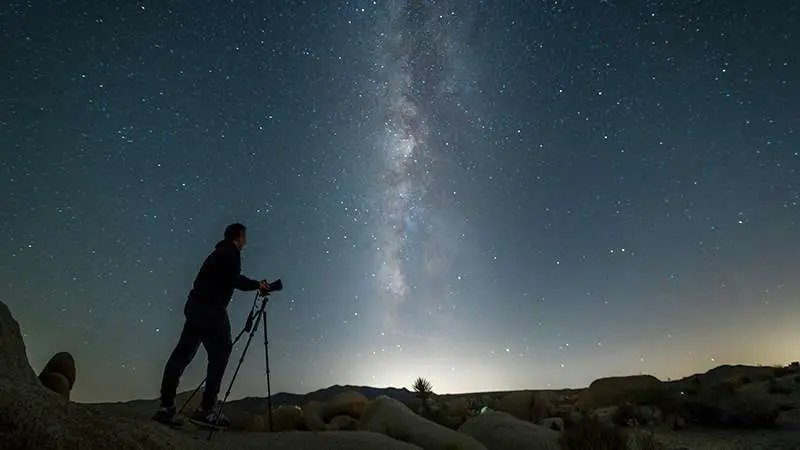
SPRING
Early spring is one of the most appealing times to go to Joshua Tree National Park. During these months, daytime temperatures are mild and the average temperatures at night are just a little chilly. Visiting Joshua Tree in the early spring will give you soft late afternoon light that illuminates the park.
SUMMER
Due to the high temperatures, summer nights are uncomfortably hot. This makes stargazing difficult in the summer season. Also, the Summer months mean long days and short nights, resulting in shorter stargazing sessions. The most suitable time to visit is March to May and October to November. I would highly recommend coming during different seasons, not summer.
WINTER
The best time to see stars in Joshua Tree is during the winter months. In winter, fewer people are visiting the park and the skies are clearer. During winter, you’ll also have the most viewing hours due to shorter days and longer nights. In December, the sunset occurs earlier, and it gets completely dark after 5 pm. Stargazing is better in the winter, as cold air holds less moisture than summer air.
OBSERVING SEASON
Autumn, Winter, and Spring offer the best times to stargaze, and many astronomers refer to this as ‘observing season’. This is the Joshua Tree Milky Way season.
This season lasts from the time when the clocks go back one hour in October (nights become 1-hour longer) to the time they go forward in March (nights become 1 hour shorter). As a result, you will find most stargazing events organized during this period.
When can you see the Milky Way in Joshua Tree? Observing season is not only the best time to see the Milky Way in Joshua Tree, it’s also the best time to stargaze in Joshua Tree!
TIME OF THE MONTH TO GO STARGAZING
The best time to stargaze Joshua Tree is also during the new moon.
Determining the phase of the moon before your planned visit will help you see the most stars possible. Visiting on or around the new moon will mean the skies will be at their absolute darkest, making it possible to view countless stars twinkling on the darkest skies.
Pro Tip
Natural moonlight reduces the light from most stars, leaving only the brightest visible. This is most noticeable around the time of the full moon. If you want to see star-peppered skies, avoiding times around the full Moon will mean you see more.
To experience the best stargazing Joshua Tree offers, be sure to visit during New Moon.
This is also the best time to find galaxies, nebulae, and other deep-sky objects through your telescope.
MORE USEFUL TIPS FOR STARGAZING
Here are some useful tips to avoid inconvenience during your Joshua Tree star gazing trip.
- Use red lights: Do not use bright white flashlights, cell phones, or white headlamps while stargazing. You can change a regular flashlight into a red light by wrapping it with red cellophane, fabric, tape, or paper.
- Bring plenty of food and water: There is no running water in most areas of the park as it is located in the desert.
- Dress in layers: Temperatures drop quickly in the late evening at Joshua Tree.
FREQUENTLY ASKED QUESTIONS
WHAT TIME DOES THE MILKY WAY RISE IN JOSHUA TREE?
The Milky Way rises in Joshua Tree at different times throughout the year. The learn the typical times per month, read my article When Can I See the Milky Way In Joshua Tree? The quick answer is, you’ll have to either get up early or stay up late. The best way to ensure you’ll see the Milky Way Core is to check an astronomy app on your phone for the days you plan to be at Joshua Tree.
WHAT TIME AT NIGHT IS BEST FOR STARGAZING?
The best time at night for stargazing is from about 2 hours after sunset until about 2 hours before sunrise. This is the darkest time of the night, so the stars will be the brightest.
WHAT TIME IS BEST FOR STARGAZING JOSHUA TREE?
The best time for stargazing at Joshua Tree is when there is no moon in the sky. Moonlight will brighten the whole sky, making the stars not seem as bright. Even if there’s a moon, it may not rise until much later, or it may set early, giving you a few good hours for stargazing with no moonlight.
Summary: Joshua Tree Stargazing
In my opinion, the best time to go stargazing in Joshua Tree National Park is in September and October. During these months, the nighttime temperatures are mild, and you can enjoy stargazing at its best.
Visiting the desert for the very first time can be an unforgettable venture. It’s very crucial to check weather conditions before entering Joshua Tree to avoid any surprises. Dressing in layers is the easiest way to help regulate your body temperature in winter.
A first-time visit to the desert during summer could be troublesome. It can be helpful to drink plenty of water and stay hydrated, even at night.
I hope this article has inspired you to add Joshua Tree National Park to your bucket list of locations for stargazing.
Grab your National Parks Pass, pick a moonless night, and you’re almost certain to have a great time stargazing at Joshua Tree!
If your travels take you to more of California, you should definitely check out my popular articles on the best places for stargazing in California.
However, if you’re planning to head East, read my articles Best Stargazing In Arizona, including Sedona, Best Stargazing In Utah, including Moab, Best Stargazing In Colorado, and Best Stargazing In Florida.
Additional articles in my Dark Sky Parks series you may enjoy:
- Acadia National Park stargazing
- Anza-Borrego stargazing
- Arches National Park stargazing
- Big Bend National Park stargazing
- Bryce Canyon stargazing
- Capulin Volcano Dark Sky Park
- Cherry Springs State Park stargazing
- Copper Breaks State Park stargazing
- Cosmic Campground stargazing
- Death Valley National Park stargazing
- Enchanted Rock stargazing
- Grand Canyon stargazing
- Great Basin National Park stargazing
- Haleakala National Park stargazing
- Massacre Rim Dark Sky Sanctuary stargazing
- Olympic National Park stargazing
- Oracle State Park stargazing
- Red Rock Canyon stargazing
- Rocky Mountain National Park stargazing
- Tonopah Stargazing Park
- Yellowstone NP stargazing
- Zion National Park stargazing




